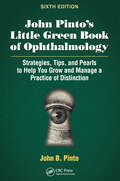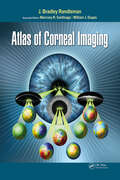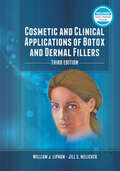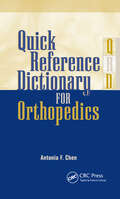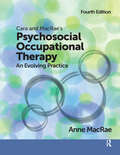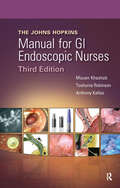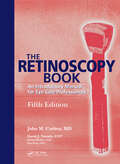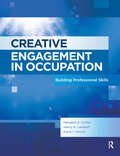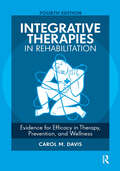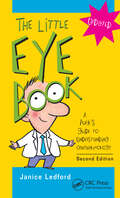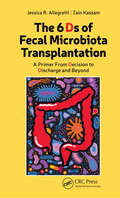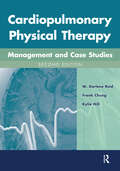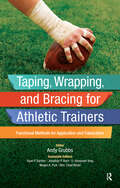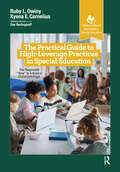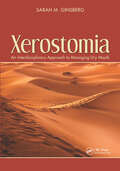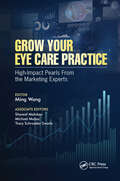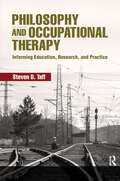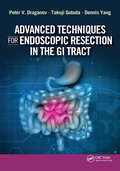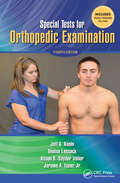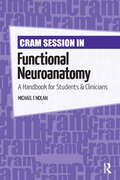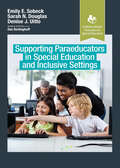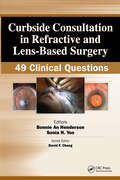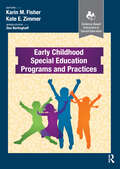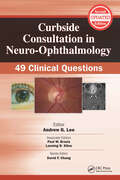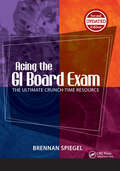- Table View
- List View
John Pinto’s Little Green Book of Ophthalmology: Strategies, Tips and Pearls to Help You Grow and Manage a Practice of Distinction
by John B. PintoThe classic reference text for surgeons and managers alike that has been improving ophthalmic practices for decades, John Pinto’s Little Green Book of Ophthalmology: Strategies, Tips, and Pearls to Help You Grow and Manage a Practice of Distinction, Sixth Edition, has been updated into a new edition. Author John B. Pinto, a world-renowned expert on the business of ophthalmic practice, has brought his decades of expertise to bear in this comprehensive guide to practice management. Inside, Pinto covers everything from the basics of business planning to esoteric and complex topics unique to ophthalmology. Topics include: Strategic business planning Leadership, governance, and discipline Finance, accounting, and patient accounts management Staff evaluation, training, and supervision Marketing and development Managing physicians Operations enhancement Facility design and management Improving an optical dispensary This Sixth Edition features updates and edits throughout the book as well as 9 new appendices covering the latest trends and advice in ophthalmic administration. It is also designed in a flexible format, allowing readers to read it straight through, or just hunt down advice on the focused problems facing their practice. As the business of ophthalmology continues to change, the proven guidance of John Pinto’s Little Green Book of Ophthalmology, Sixth Edition, will help any practice adapt and thrive.
Atlas of Corneal Imaging
by J. Bradley RandlemanA comprehensive reference for physicians, surgeons, and trainees, Atlas of Corneal Imaging covers all aspects of corneal imaging from basic map interpretation to advanced diagnostic uses and features over 1200 illustrative images and figures representing a wide variety of devices and techniques.Drs. J. Bradley Randleman, Marcony Santhiago, and William J. Dupps Jr guide readers through the process of analyzing corneal images using a multitude of different techniques, technologies, and individual devices. This creates a complete picture of the cornea’s basic methods and pathological processes and allows readers to directly visualize how their technology would display the pathology in question.Atlas of Corneal Imaging is designed to help practitioners recognize subtle findings and evaluate signs of weakening or pathology, no matter how they present or what device is being used. Multiple iterations of the same clinical condition are shown with numerous complementary images for the same eye to provide a comprehensive presentation of each case.Chapters feature information on: Topographic patterns and mapping Corneal ectasia evaluations Cornea and refractive surgery evaluations Clinical correlations with corneal disorders Cornea and refractive surgery complications Evaluation for cataract surgery Atlas of Corneal Imaging fills a significant void in corneal imaging resources available today by presenting an image-first approach to understanding all the many different technologies for imaging the cornea.
Cosmetic and Clinical Applications of Botox and Dermal Fillers
by William J. Lipham Jill MellicherThere has been a recent explosion of public interest in less invasive facial rejuvenation products and treatments. At the forefront of this are the U.S. FDA Approvals of Botox and Xeomin injections.In addition to the broad array of cosmetic applications for botulinum toxin, a new range of functional treatments is similarly beginning to emerge. These treatments include creating a “chemical” tarsorrhaphy to promote corneal healing, reducing thyroid-associated eyelid retraction, and—most compelling—reducing the frequency and severity of muscle tension and migraine headaches. These new applications significantly expand the scope of botulinum toxin treatments for medical disorders that have traditionally included the treatment of strabismus as well as a number of disorders of spasticity.Cosmetic and Clinical Applications of Botox and Dermal Fillers, Third Edition by Dr. William J. Lipham and Dr. Jill S. Melicher continues to evolve and advance along with these applications, addressing important information for anyone interested in expanding his or her clinical practice in this area.This updated and revised Third Edition also describes how to perform a broad range of treatments with a wide variety of dermal filler agents, including the newer hyaluronic acid and poly-l-lactic acid derivatives.Topics inside the Third Edition include: Treatment of blepharospasm, meige syndrome, and hemifacial spasm Botulinum toxin as a treatment for functional disorders Neuro-ophthalmic uses for botulinum toxin Cosmetic applications of botulinum toxin Periorbital rejuvenation using cosmetic filler agents and fat injection Marketing botulinum toxin and dermal filler agents to build your practice Additionally, an accompanying video website with nine supplemental videos is included to demonstrate the techniques discussed.Video topics include: Botulinum toxin for benign essential blepharospasm Botulinum toxin for hemifacial spasm Botulinum toxin for headaches Botulinum toxin chemical brow lift Botulinum toxin for forehead rhytids Botulinum toxin for glabellar rhytids Botulinum toxin for treatment of orbicularis lateral Hyaluronic acid filler for perioral rejuvenation Hyaluronic acid filler for the nasolabial fold Cosmetic and Clinical Applications of Botox and Dermal Fillers, Third Edition is perfect for anyone interested in the use of Botox and dermal filler agents for a wide variety of functional and minimally invasive facial rejuvenation procedures. General ophthalmologists, anterior segment surgeons, dermatologists, facial plastic surgeons, residents, and fellows alike will benefit from adding this valuable book and video website to their collection.
Quick Reference Dictionary for Orthopedics
by Antonia ChenThe Quick Reference Dictionary for Orthopedics by Dr. Antonia Chen is a portable, all-in-one, orthopedic resource for anyone who works with orthopedic patients. This pocket-size book focuses on commonly used orthopedic terms and definitions, with over 2,200 defined words — including anatomic terms and medical root terminology.Quick Reference Dictionary for Orthopedics also includes 25 in-depth appendices on a variety of orthopedic related topics such as imaging modalities, medication references for analgesia, antibiotics, and anticoagulation. Additionally, orthopedic eponyms, acronyms, and abbreviations are defined and described in detail.The anatomy of muscles, bones, and nerves, and vessels are described in detail, as well as the aspiration and injection of common joints. Quick Reference Dictionary for Orthopedics also covers common fracture classifications along with the appropriate splinting, bracing, or casting technique.Quick Reference Dictionary for Orthopedics provides an important, at your fingertips guide for anyone who works with orthopedic patients, including orthopedic surgeons, residents, fellows, medical students, physical therapists, athletic trainers, occupational therapists, and nurse practitioners.
Cara and MacRae's Psychosocial Occupational Therapy: An Evolving Practice
by Anne MacRaePhilosophical principles of recovery and justice are driving changing attitudes in the behavioral health arena, but the practical methods used to incorporate these principles needs further clarity. To address this need, Cara and MacRae’s Psychosocial Occupational Therapy: An Evolving Practice,Fourth Edition is completely revised and reorganized. Relevant information from previous editions, including assessments, techniques, diagnoses and specialized programs are interwoven throughout the text with a new emphasis on social issues and lived experiences. Dr. Anne MacRae designed this Fourth Edition to meet practice challenges as the occupational therapy profession continues to evolve to meet the current needs of our communities. It includes specific examples of programs, groups, assessments, activities, techniques, approaches, and outcomes. Inside Cara and MacRae’s Psychosocial Occupational Therapy: An Evolving Practice, Fourth Edition: All new chapters on philosophical worldviews, psychiatric institutions and hospitals, community behavioral health services, and direct service provision, as well as consultation and program development. Reorganized and expanded chapters on built, virtual and natural environments, as well as cultural identity and context. A new chapter on personal and social identity discusses the aspects of identity that are linked to mental wellness/illness including personal choice, family, roles and habits, spirituality, rituals and traditions, as well as the profound effects of trauma, stigma, poverty, and violence. Trauma, stigma, poverty and violence are also identified throughout the text, especially in the case illustrations. Revised chapters on mental health of infants, children, adolescents and older adults. New chapters on mental health of emerging adults and mid-life adults. Instructors in educational settings can visit www.efacultylounge.com for additional materials to be used in the classroom. While occupational therapists can certainly use this material for providing direct services and being part of a team, Cara and MacRae’s Psychosocial Occupational Therapy: An Evolving Practice, Fourth Edition is also an invaluable resource for defining and explaining psychosocial occupational therapy, and in supporting our roles in consultation and program development.
The Johns Hopkins Manual for GI Endoscopic Nurses
by Mouen Khashab Toshunia Robinson Anthony KallooThe Johns Hopkins Manual for GI Endoscopic Nurses, Third Edition outlines nursing care before, during, and after endoscopic procedures. Written with both the novice and experienced nurse in mind, the Third Edition of The Johns Hopkins Manual for GI Endoscopic Nurses provides practical tips for all basic and advanced endoscopic procedures.Dr. Anthony Kalloo is joined by Mouen Khashab and Toshunia Robinson on the Third Edition of this popular manual. The Johns Hopkins Manual for GI Endoscopic Nurses features up-to-date guides to new endoscopic procedures and techniques, such as fiducial placement, balloon-assisted enteroscopy, Barrett’s ablation, Spyglass cholangioscopy, and pancreatoscopy. Additional chapters cover sedation, antibiotic prophylaxis, disinfection, and the management of patients on anticoagulation medication.General guidelines for moderate sedation, equipment disinfection, and sterilization are also discussed, as well as special considerations for patients with specific medical conditions who are undergoing endoscopy.Endoscopy nurses, gastroenterology fellows, and gastroenterology practitioners alike can use The Johns Hopkins Manual for GI Endoscopic Nurses, Third Edition’s endoscopic preparation regimens to facilitate the correct instruction of patients, reducing the likelihood of unsuccessful procedures. This spiral-bound resource also includes the definitions and indications for both common and advanced endoscopic procedures along with listings of necessary equipment.The Johns Hopkins Manual for GI Endoscopic Nurses, Third Edition is easy to read and comprehend, with photographs and illustrations replacing cumbersome long descriptions, making this the ideal reference for a nurse on the go.
The Retinoscopy Book: An Introductory Manual for Eye Care Professionals
by John M. CorboyFor over 25 years, The Retinoscopy Book: An Introductory Manual for Eye Care Professionals has been the only basic instruction manual designed specifically to teach the art of clinical retinoscopy. This best-selling classic has been updated and revised to include the latest changes involving the retinoscope, and to meet the developing needs of students in ophthalmology and optometry. Sections on minus cylinders, concave mirror retinoscopy for high refractive errors, and a catalog of instruments have been expanded to reflect the most recent innovations. New sections on retinoscopy after refractive surgery and instrument maintenance are unique to this fifth edition.This text is designed to supplement the Joint Commission on Allied Health Personnel in Ophthalmology (JCAHPO) instruction courses for technicians or to facilitate a do-it-yourself training program for ophthalmology residents, ophthalmic technicians, optometry students, and other eye care professionals in training. Figures and illustrations supplement time-tested exercises to facilitate learning. The user-friendly format prevalent throughout the text enables students to develop a complete understanding of the retinoscope and its many uses.
Creative Engagement in Occupation: Building Professional Skills
by Margaret Coffey Nancy Lamport Gayle HerschIn occupational therapy, creative thinking and problem-solving skills are critical aspects of delivering appropriate intervention programs. These professional characteristics are essential components in the clinical reasoning process that facilitate meaningful therapy.Creative Engagement in Occupation: Building Professional Skills is a comprehensive text on the recognition and development of creative thinking as a primary tool in occupational therapy.Margaret S. Coffey, Nancy K. Lamport, Gayle I. Hersch, and their contributors, guide occupational therapy students and clinicians in identifying their creative potential for designing activities to address client goals. By actively engaging in the creative process, readers can enlist the creative potential of their clients to overcome or compensate for limitations in occupational performance.The skillful application of activity analysis is advanced through the reader’s use of their own creativity in developing meaningful intervention programs for clients. References to the AOTA’s Occupational Therapy Practice Framework further support this aspect of the text as readers begin to sense and use their own and the client’s creativity in developing collaborative therapist-client partnerships.Experience these creative opportunities inside Creative Engagement in Occupation: Building Professional Skills through the use of case studies, discussion and individual activities, role playing, and worksheets. Each chapter offers didactic and experiential applications to develop and practice using creativity as it applies to occupational therapy practice.Included with the text are online supplemental materials for faculty use in the classroom. Creative Engagement in Occupation: Building Professional Skills offers a unique opportunity for occupational therapy students, faculty, and clinicians to develop their potential in delivering creative occupational therapy intervention.
Integrative Therapies in Rehabilitation: Evidence for Efficacy in Therapy, Prevention, and Wellness
by Carol M. DavisFor more than 20 years, Integrative Therapies in Rehabilitation continues to be a most researched resource on complementary and alternative therapies in rehabilitation. This renowned text, now in its Fourth Edition, relates the updated scientific evidence and the clinical efficacy of integrating what have now become well known complementary and alternative therapies in rehabilitation to successfully improve patient outcomes. This text has been developed to accompany university courses in complementary and alternative therapies, as a reference manual for clinical practices, and as a resource for those interested in the science behind holistic therapies. Holistic therapies are those therapies not commonly found in allopathic medicine that are intended to stimulate a therapeutic response from both the body – neuromusculoskeletal and cardiopulmonary systems – and the mind. Integrative Therapies in Rehabilitation, Fourth Edition by Dr. Carol M. Davis is particularly designed for those health professionals who want to understand the scientific foundation and peer reviewed research supporting complementary and alternative therapies. The Fourth Edition is divided into two parts. The beginning chapters describe the latest cellular biology science and explain the theories put forth on the overall mechanisms of action of the effect of these various therapies on the soft tissue, fascia and nervous systems. The first part also chronicles the advancement of scientific research in the various therapies since the 1980’s to explain, in cellular physiology terms, the outcomes observed by using a number of holistic therapies. The second part presents various therapies commonly integrated with allopathic therapies in rehabilitation – body work therapies, mind/body therapies, and energy work therapies. The text describes each therapy with a history, cellular mechanism of action, and an up-dated reference section of the evidence of efficacy for the therapy as reported in the literature, often concluding with a case example.Integrative Therapies in Rehabilitation, Fourth Edition will be the go-to resource for health professionals to understand the scientific evidence and efficacy of complementary and alternative therapies for rehabilitation and improving patient outcomes.
The Little Eye Book: A Pupil's Guide to Understanding Ophthalmology
by Janice K. LedfordThe Little Eye Book: A Pupil’s Guide to Understanding Ophthalmology is an easy-to-understand introduction to the field of eye care that has been updated into a new Second Edition. This book is written with the non-physician in mind, so you won’t be bogged down with heavy details, yet every basic fact that you need is right here. With photographs as well as drawings and helpful tables and charts, this conversational-style text packs a big punch. Beginning with an illustrated description of ocular anatomy, the book sweeps you into the workings of vision with hardly a blink, where you’ll learn what happens when light meets the eye. But life is never perfect, and sometimes the eye isn’t either. You’ll get a good overview of disorders and trauma, from lids to optic nerves. The all-important red eye has a section all its own, including symptoms, signs, what’s an emergency and what’s not. A chapter on eye symptoms and their potential causes will help you understand patients’ complaints.New to the Second Edition: A chapter on refractive errors and their correction, including a section on glasses and contact lenses New technology topics including optical coherence tomography, scanning laser tomography, wavefront analysis and more Updated information on medications and refractive surgery Includes over 65 figures and 10 tables Now you will finally understand how the eye works without spending hours trying to get through an overwhelming medical book. Need to know how to take a history, check vision or pupils, or give someone eye medications? It’s in here! Wonder what special testing is available? We tell you! Have questions about surgery or medical treatment? Yep, we covered that, too, and more! Written by Janice K. Ledford, an eyecare professional with over 26 years of experience, The Little Eye Book: A Pupil’s Guide to Understanding Ophthalmology, Second Edition is perfect for anyone who works in the eye care industry or with patients, but isn’t an ophthalmologist.
The 6 Ds of Fecal Microbiota Transplantation: A Primer from Decision to Discharge and Beyond
by Jessica Allegretti Zain KassamA practical handbook on fecal microbiota transplantation (FMT) for physicians, nurses, physician assistants, students, residents, and fellows, The 6 Ds of Fecal Microbiota Transplantation: A Primer from Decision to Discharge and Beyond provides a clinical framework to understand and administer this treatment as safely and effectively as possible. FMT has emerged as a promising treatment for C. difficile infection (CDI), and there is a major need for educational resources on the topic. Drs. Jessica Allegretti, Zain Kassam, and their expert contributors are leaders in the field and have collectively cared for thousands of patients suffering from recurrent CDI who have benefitted from FMT. This guide provides practical tools, clinical pearls, and answers to frequently asked questions. Beginning with introductory information on the microbiome and exploring the history of FMT, The 6 Ds of Fecal Microbiota Transplantation outlines a step-by-step checklist for administering FMT: Decision: Who is the right CDI patient to receive FMT? What clinical questions should you ask patients in your FMT clinical assessment? Donor: How do you select and screen a donor for FMT? Discussion: What are the risks, benefits, and alternatives that need to be discussed with patients? Delivery: What is the best delivery method for FMT—colonoscopy, nasogastric tube, enema, or capsules? Discharge and follow-up: What is the ideal post-FMT care? How should you council patients following FMT? Discovery: What are the most promising emerging clinical applications for FMT? What is the evidence for FMT in obesity, autism, irritable bowel syndrome, inflammatory bowel disease, antibiotic resistant bacteria, and liver disease? Arming healthcare professionals with the ability to answer questions from patients regarding FMT and the microbiome, The 6 Ds of Fecal Microbiota Transplantationprovides a pragmatic guide for this exciting treatment.
Cardiopulmonary Physical Therapy: Management and Case Studies
by W. Darlene Reid Frank Chung Kylie HillCardiopulmonary Physical Therapy: Management and Case Studies, Second Edition is a unique and succinct textbook for the classroom that blends clinical notes on assessment and management together with case-based instructional approaches to cardiopulmonary care for acute and ambulatory care patients. This one-of-a-kind text describes current approaches that cover traditional physical therapist management strategies and includes evidence-based chapters on early mobilization and exercise training on a wide range of cardiopulmonary patient groups.The updated Second Edition presents twenty-four cases that were designed to complement each chapter topic and represent the most common pulmonary, cardiac, and neurological conditions that are typically managed in cardiopulmonary care. These cases have been carefully selected and developed over several years to illustrate a spectrum of clinical issues essential for the preparation of the entry-level therapist. The very interactive nature of the case history approach is engaging and provides the opportunity to work through many of the steps of the clinical decision-making process.Cardiopulmonary Physical Therapy: Management and Case Studies, Second Edition also includes answer guides for the questions posed in the assessment and management chapters, as well as for the twenty-four cases.New in the Second Edition: Twenty-four carefully selected evidence-based cases designed to go “hand-in-hand” with chapter topics An international perspective that is relevant to physical therapy practice in several countries Detailed chapter on noninvasive ventilation and mechanical ventilation Several chapters describe early mobilization and exercise training for a range of cardiopulmonary patient groups including those admitted to an intensive care unit Faculty will benefit from the “Talk Me Through” PowerPoint slides, which provide a great opportunity for independent learning and complement classroom teaching The two-fold evidence and case-based learning approach used by Dr. W. Darlene Reid, Frank Chung, and Dr. Kylie Hill allows for a more engaging experience. The inclusion of interactive materials will allow students to learn and develop skills to prepare themselves for their professional transition while clinicians can use the text as a reference tool.
Taping, Wrapping, and Bracing for Athletic Trainers: Functional Methods for Application and Fabrication
by Andy GrubbsFor many years, sports medicine and health care practitioners have used taping and bracing for both the prevention and rehabilitation of injuries; consequently, specific protocols and techniques have evolved to ensure that the results are functional. With numerous methods available for orthopedic injuries, many texts go into all the applications in a given area or injury and leave readers wondering which one works best or is more useful. Taping, Wrapping, and Bracing for Athletic Trainers: Functional Methods for Application and Fabrication is a collection of some of the most commonly used and most functional taping, wrapping, and bracing techniques for orthopedic injuries.Andy Grubbs has designed this text to not only show the best method(s) for a given area but to add another method to each clinician’s bag of tricks. Taping, Wrapping, and Bracing for Athletic Trainers focuses on the most functional and useful methods in clinical settings and each application is performed in the proper manner to ensure functionality. With the step-by-step instructions, athletic trainers, coaches, and allied health care practitioners will gain comprehensive knowledge and practical skills to understand, reproduce and master the useful taping techniques. While this book offers material recommendations for each technique, it is important to understand that some taping techniques can be performed with a number of different types of taping materials.Features: Includes over 300 images Videos accompany each technique to further capture application and assist in technique mastery Covers basic anatomy and common injuries for each body region, as well as casting and splint making techniques Offers material recommendations for each bracing and taping technique Included with the text are online supplemental materials for faculty use in the classroom.Taping, Wrapping, and Bracing for Athletic Trainers: Functional Methods for Application and Fabrication will enhance any athletic training student or clinician’s current techniques along with providing recommended applications for taping and bracing for both prevention and rehabilitation of injuries.
The Practical Guide to High-Leverage Practices in Special Education: The Purposeful “How” to Enhance Classroom Rigor (Evidence-Based Instruction in Special Education)
by Ruby L. Owiny Kyena CorneliusDesigned for teacher preparation programs as well as teacher professional development, The Practical Guide to High-Leverage Practices in Special Education: The Purposeful “How” to Enhance Classroom Rigor is the first book of its kind to introduce multiple HLPs working in tandem to implement evidence-based practices (EBPs).The Practical Guide to High-Leverage Practices in Special Education is a powerful tool for those dedicated to improving student outcomes. Planned with the practitioner in mind, the text’s main objective is for teachers to recognize EBPs as “what” they teach and HLPs as “how” they teach. The book is written with a focus on inclusive education, making it a valuable resource for both general and special educators.What’s included in The Practical Guide to High-Leverage Practices in Special Education: A focus on one HLP per chapter and descriptions of connected HLPs and how to use them for implementing featured EBPs Classroom scenarios for both elementary and secondary classrooms Tables of the crosswalks of connected HLPs and EBPs with resources forfurther learning The Practical Guide to High-Leverage Practices in Special Education: The Purposeful “How” to Enhance Classroom Rigor provides educators with the understanding of how HLPs and EBPs connect to effectively implement them for student success and is also an effective teaching and learning tool for teacher education preparation programs.
Xerostomia: An Interdisciplinary Approach to Managing Dry Mouth
by Sarah GinsbergAn interdisciplinary textbook on dry mouth, Xerostomia: An Interdisciplinary Approach to Managing Dry Mouth provides an overview of xerostomia for physicians, dentists, nurses, speech-language pathologists, and otolaryngologists who encounter the condition in their practice. Xerostomia is a common condition, yet only one in seven cases are referred to a speech-language pathologist or otolaryngologist for treatment. Featuring contributions from speech-language pathologists, otolaryngologists, dentists, oral pathologists, and nurses, the text’s interdisciplinary approach and evidence-based framework provides practitioners with an awareness and understanding of xerostomia that will improve interprofessional coordination and enhance patient care. With a robust accompanying website including patient education resources, Xerostomia addresses the following topics: An otolaryngologist’s view of xerostomia, including causes, symptoms, evaluation, and treatment Patient perspectives of living with xerostomia, including quality of life measures and new research findings Effect of xerostomia on dental and oral health Voice disorders associated with xerostomia Impact of xerostomia on swallowing The science of saliva, including composition and production Pharmacological management of xerostomia Xerostomia: An Interdisciplinary Approach to Managing Dry Mouth provides indispensable information for general practitioners, internists, dentists, nurses, otolaryngologists, speech-language pathologists, and speech-language pathology students, as well as any health care practitioners who encounter patients with xerostomia.
Grow Your Eye Care Practice: High Impact Pearls from the Marketing Experts
by Ming WangA crash course in marketing for eye care professionals, Grow Your Eye Care Practice: High Impact Pearls from the Marketing Experts guides readers through this crucial area of business development.With an increase in patients undergoing elective procedures and an increase in the amount of providers, marketing has become the most important way for eye care professionals to grow their practices and differentiate themselves from their competition. Since marketing is not addressed in any formal course in medical school, optometry school, residency or fellowship, many eye care professionals lack basic understanding and skills in this area of growing importance to their businesses.To meet this critical need, editor Dr. Ming Wang and associate editors Shareef Mahdavi, Michael Malley and Dr. Tracy Swartz have created this essential, timely handbook aggregating the key ophthalmic marketing pearls, teachings and experiences of some of the leading national and international marketing experts.Grow Your Eye Care Practice begins with an overview of the history and current state of ophthalmic marketing, including a fascinating look at the commoditization of eye care as was demonstrated with the introduction of LASIK. The core chapters address foundational and innovative marketing concepts and their application to eye care, including: Market research, segmentation, targeting and positioning Patient experience Branding versus call to action Word of mouth referrals Digital marketing, including social media, websites and SEO Innovative marketing approaches Ethics and laws governing medical marketing Upcoming disruptive marketing technologies Grow Your Eye Care Practice: High Impact Pearls from the Marketing Experts is an indispensable desktop reference for all eye care professionals--ophthalmologists, optometrists, administrators, practice managers, business associates, residents, fellows, medical students and optometry students—who wish to improve their marketing skills, grow their practices and differentiate themselves from their competition.
Philosophy and Occupational Therapy: Informing Education, Research, and Practice
by Steven TaffPhilosophy and Occupational Therapy: Informing Education, Research, and Practice provides an overview of the most influential philosophical movements from past to present and shows how these philosophies are a foundational, yet underutilized, element of occupational therapy education, research, and practice. Editor Steven D. Taff, PhD, OTR/L, FNAP, FAOTA, fills a gap in existing occupational therapy literature by exploring the major thinkers and concepts of numerous different philosophical movements and examining their implications. Taff and a multitude of chapter authors demonstrate that the vital points of human existence are found in philosophy as well as science, and that occupational therapy should incorporate a clearly articulated philosophical perspective into its evidence-based and measurement-driven paradigm. Each chapter offers a basic description of a philosophy, outlines major thinkers and concepts and ultimately summarizes the implications for occupational therapy education, research and practice. Philosophy and Occupational Therapy: Informing Education, Research, and Practice is a unique and essential book for occupational therapy educators, researchers, and clinicians that will enrich the teaching-learning process, ground research with depth and clarity, and spark discussion among professionals about reviving the use of philosophy in current occupational therapy practice.
Advanced Techniques for Endoscopic Resection in the GI Tract
by Dennis Yang Peter Draganov Takuji GotodaSurgery has traditionally been the standard of care for the treatment of neoplastic lesions in the gastrointestinal tract. With advances in endoscopic resection techniques, there has been a paradigm shift in how to approach many of these precancerous and early cancerous lesions. Potential advantages of endoscopic resection include its minimally invasiveness which often translates into quicker patient recovery. In recent years, there have been major strides in safety and efficacy of minimally invasive endoscopic approaches with ongoing advances in therapeutic endoscopy. Advanced Techniques for Endoscopic Resection in the GI Tract by Drs. Peter V. Draganov, Takuji Gotoda, and Dennis J. Yang provides an in-depth analysis of the current state of advanced endoscopic techniques for the evaluation and resection in the gastrointestinal tract. Each chapter in the book addresses specific topics such as: endoscopic evaluation of lesions technical aspects of the procedure management of adverse events post-procedural care and follow-up Advanced Techniques for Endoscopic Resection in the GI Tract provides a comprehensive review of all the different aspects of advanced endoscopic resection in the gastrointestinal tract which makes it ideal for interventional GI endoscopists and general gastroenterologists, as well as surgeons.
Special Tests for Orthopedic Examination
by Jeff G. Konin Denise Lebsack Alison Valier Jerome A. Isear, Jr.First published more than 20 years ago, Special Tests for Orthopedic Examination, now in its Fourth Edition, continues to follow the authors’ initial goals of providing a simple, pocket-sized manual for practical learning purposes. The Fourth Edition provides critical and invaluable information on the most current and practical special tests used during an orthopedic examination. The efficient user-friendly, spiral-bound format allows for easy access to individualized special tests. Special Tests for Orthopedic Examination, Fourth Edition includes 160 special tests, 6 of which are new: Ballottement Test Gerber’s Test (Lift-Off Test) Painful Arc Sign Thessaly Test Quad Active Test Lelli Test for Anterior Cruciate Ligament (ACL) Injuries Inside Special Tests for Orthopedic Examination Fourth Edition, Jeff G. Konin, Denise Lebsack, Alison R. Snyder Valier, and Jerome A. Isear, Jr. have included a new section on evidence, where the authors have highlighted systematic reviews, meta-analyses, or single articles to address reliability, sensitivity, and specificity of the special tests, where available. What is new and updated in the Fourth Edition: Includes a video website that provides visually enhanced dimensional and motion analysis of each special test performed Includes 160 special tests, 6 of which are new to this edition Includes information on reliability, sensitivity, and specificity presented in a table format New evidence section highlight systematic reviews, meta-analyses, or single articles for special tests, where available New color images for each test Updated references for all tests Bonus Material!Special Tests for Orthopedic Examination, Fourth Edition includes a video website with each new book purchase. This video website offers a unique approach that provides a visually enhanced dimensional and motion analysis of each special test performed. The video segments will help students and clinicians better understand the test motion in order to perform the test accurately during an orthopedic examination. The simple yet succinct information provided throughout the manual and on the video website will help clinicians make informed decisions during an orthopedic examination, from understanding to performing and evaluating the special tests. Special Tests for Orthopedic Examination, Fourth Edition will carry on the tradition of past editions as being the premier resource for thousands of students, clinicians, and rehabilitation professionals.
Cram Session in Functional Neuroanatomy: A Handbook for Students & Clinicians
by Michael NolanWhen all you need is a basic understanding of the human nervous system, look to Cram Session in Functional Neuroanatomy: A Handbook for Students & Clinicians.This handbook gives you basic information in a readily accessible format, as well as more detailed concepts that will allow you to better understand not only how the human nervous system works, but how injuries and disease affect experience and behavior, including cognitive and intellectual functions.Cram Session in Functional Neuroanatomy: A Handbook for Students & Clinicians by Dr. Michael F. Nolan is a concise and illustrated quick reference that highlights important anatomical and physiological principles of the nervous system. These key points will enhance understanding of the nervous system and how specific populations of nerve cells and neural systems influence human experience and behavior.WHAT IS IN YOUR CRAM SESSION?• Concise and focused explanations of topics specifically related to neuroanatomy • Topic self-assessment questions formatted as short answer exercises, ideal for exam review and preparation• List of laboratory structures – an excellent tool to aid faculty with additional methods of learning• More than 75 photographs and illustrations Included with the text are online supplemental materials for faculty use in the classroom.Cram Session in Functional Neuroanatomy: A Handbook for Students & Clinicians is a perfect text for physical therapy students and other medical and health professionals in neurology and neurosurgery.
Supporting Paraeducators in Special Education and Inclusive Settings (Evidence-Based Instruction in Special Education)
by Sarah Douglas Emily Sobeck Denise UittoSupporting Paraeducators in Special Education and Inclusive Settings provides an in-depth look at the role of pre- and in-service teachers as supervisors of paraeducators within special education and inclusive settings.The latest entry within the Evidence-Based Instruction in Special Education series, Supporting Paraeducators in Special Education and Inclusive Settings serves as an instructional tool for pre-service teachers and educators within higher education coursework, as well as a resource for in-service teachers. This text supports teachers in strengthening their knowledge and supervisory skills necessary to supervise and manage paraeducators in educational environments.Through objectives, scenarios, content, and chapter questions, Drs. Sobeck, Douglas, and Uitto provide a thorough and applicable overview of working with and supervising paraeducators. In this text the roles and responsibilities of paraeducators, teachers, and school administrators relative to paraeducator training and supervision will be detailed, as well as tips for collaboration.Included with the text are online supplemental materials for faculty use. School leaders and higher education faculty can use the online site for materials to support pre-service training within teacher preparation programs and professional development for in-service teachers.Supporting Paraeducators in Special Education and Inclusive Settings fills an important need in the field and is a vital resource for current and future teachers when working with paraeducators.
Curbside Consultation in Refractive and Lens-Based Surgery: 49 Clinical Questions (Curbside Consultation in Ophthalmology)
by Bonnie An Henderson Sonia H. YooAre you looking for concise, practical answers to questions that are often left unanswered by traditional references on refractive surgery? Are you seeking brief, evidence-based advice for the daily examination of patients? Curbside Consultation in Refractive and Lens-Based Surgery: 49 Clinical Questions provides quick and direct answers to the thorny questions most commonly posed during a “curbside consultation” between experienced clinicians. Drs. Bonnie An Henderson and Sonia H. Yoo have designed this unique reference in which refractive specialists offer expert advice, preferences, and opinions on tough clinical questions commonly encountered by ophthalmologists, residents, and other health care professionals. The unique Q&A format provides quick access to current information related to refractive and lens-based surgery with the simplicity of a conversation between two colleagues. Images, diagrams, and references are included to enhance the text and to illustrate clinical diagnoses and treatment plans. Based on clinical scenarios that a refractive surgeon might encounter in real life, Curbside Consultation in Refractive and Lens-Based Surgery provides information basic enough for residents while also incorporating expert pearls that even high-volume ophthalmologists will appreciate. General ophthalmologists and residents alike will enjoy the user-friendly and casual format.Some of the questions that are answered: How do I manage epithelial ingrowth after LASIK? What if it recurs? Should I perform PRK in patients with forme fruste keratoconus? How do I manage patients with dry eyes after LASIK surgery? How do I determine my surgically induced astigmatism? Is a monocular implantation of a multifocal IOL tolerated? How do you manage an unhappy multifocal patient who is experiencing halos and glare?
Early Childhood Special Education Programs and Practices (Evidence-Based Instruction in Special Education)
by Karin Fisher Kate ZimmerEarly Childhood Special Education Programs and Practices is a special education textbook that prepares pre- and in-service teachers with the knowledge, skills, and dispositions to deliver evidence-based instruction to promote positive academic and behavioral outcomes for young children (prekindergarten through second grade) with development delays and/or disabilities.Early Childhood Special Education Programs and Practices intertwines inclusive early childhood practices by using real-life anecdotes to illustrate evidence-based practices (EBPs) and procedures. The authors, experts in their fields, emphasize high-leverage practices, EBPs, and culturally sustaining pedagogy and align them with the practices, skills, and competencies recommended by the Council for Exceptional Children’s Division for Early Childhood. Families, administrators, and teacher educators of pre- and in-service early childhood special education and general early childhood education programs alike will find this book useful.Included in Early Childhood Special Education Programs and Practices are: An overview of early childhood and development of children ages 4 to 8 Strategies for relationship building with students, families, communities, and school personnel Tips on creating a caring and positive classroom environment Chapters devoted to evidence-based instruction in core subjects of reading and writing, mathematics, science, and social studies for students with disabilities in pre-K to second grade More than 80 images, photos, tables, graphs, and case studies to illustrate recommended Practices Also included with the text are online supplemental materials for faculty use in the classroom, consisting of an Instructor’s Manual and PowerPoint slides.Created with the needs of early childhood special educators in mind, Early Childhood Special Education Programs and Practices provides pre- and in-service teachers with the skills and practices they need to serve young children, their families, and communities across settings.
Curbside Consultation in Neuro-Ophthalmology: 49 Clinical Questions (Curbside Consultation in Ophthalmology)
by Paul Brazis Andrew Lee Lanning B. KlineCurbside Consultation in Neuro-Ophthalmology has been updated into a Second Edition! The Second Edition contains new questions and is completely updated! Curbside Consultation in Neuro-Ophthalmology: 49 Clinical Questions, Second Edition contains new questions and brief, practical, evidence-based answers to the most frequently asked questions that are posed during a “curbside consultation” between surgical colleagues. Dr. Andrew G. Lee and associate editors Dr. Paul W. Brazis and Dr. Lanning B. Kline have designed this unique reference in which neuro-ophthalmologists offer expert advice, preferences, and opinions on tough clinical questions commonly associated with neuro-ophthalmology. The unique Q&A format provides quick access to current information related to neuro-ophthalmology with the simplicity of a conversation between two colleagues. Images, diagrams, and references are included to enhance the text and to illustrate common clinical dilemmas.Some of the questions that are answered inside theSecond Editioninclude: What is the evaluation for papilledema? What is the work up for third nerve palsy? What is the treatment for giant cell arteritis? What is the evaluation for optic disc edema with a macular star? What is the evaluation for anisocoria? Curbside Consultation in Neuro-Ophthalmology: 49 Clinical Questions, Second Edition provides information basic enough for residents while also incorporating expert pearls that even high-volume ophthalmologists will appreciate. Residents, fellows, and practicing physicians alike will benefit from the user-friendly, casual format and the expert advice contained within.
Acing the GI Board Exam: The Ultimate Crunch-Time Resource
by Brennan SpiegelAcing the GI Board Exam: The Ultimate Crunch-Time Resource has been updated into a Second Edition. The Second Edition contains new vignettes, a discussion on Maintenance of Certification (MOC) Exam, and discussion on test relevancy for residency rotations! In today’s fast-paced world, gastroenterology and hepatology residents and fellows struggle to find the time to study for the board exams, prepare for the recertification exam, prepare for teaching rounds, or just plain read. What is the best way to effectively prepare and study, if reading multiple resources can’t seem to fit into your daily schedule? The answer to your study questions (and study time!) can be found inside the newly updated Second Edition of Acing the GI Board Exam: The Ultimate Crunch-Time Resource! Why You Will Need to Read Acing the GI Board Exam, Second Edition: New! 41 new and carefully vetted board-style vignettes with color images New! Brief discussion on the Maintenance of Certification (MOC) Exam New! Discussion on test relevancy for residency rotations Comprehensive yet succinct answers using a high-yield format Emphasis on key clinical pearls and “board buzzwords” Answers to classic board “threshold values” questions that you need to know but always seem to forget Rapid-fire, crunch-time exam with 200 classic one-liners Dr. Brennan Spiegel has collected every pearl of wisdom, high-yield factlet, "Board buzzword," micrograph, and classic imaging study he could muster, all while keeping Acing the GI Board Exam: The Ultimate Crunch-Time Resource, Second Edition a manageable size. Acing the GI Board Exam, Second Edition fills the unmet need in board review by presenting time-tested and high-yield information in a rational, useful, and contextually appropriate format suitable studying for the board exams and preparing for the recertification exam.Chapters Include: A compilation of general lessons learned from past test-takers “Tough Stuff” board review vignettes Board review “Clinical Threshold Values” “Crunch-Time” Self-Test and Answer Guide—time to get your game on! With its focus on pearl after pearl, emphasis on images, and attention to high-yield “tough stuff” vignettes you don’t know the answers to (yet), Acing the GI Board Exam, Second Edition is truly the ultimate crunch-time resource for acing the GI and Hepatology examination, taking recertifying examinations, looking good on clerkship rounds, or for just challenging yourself with interesting and entertaining vignettes.
